Paolo Veronese Biography
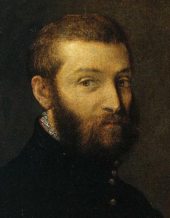
Paolo Caliari was born in 1528 in Verona, Italy; he later came to be known as “Veronese” after his birthplace. At fourteen years old he was apprenticed to several local masters in turn, and eventually, he found himself a mentor in the architect Michele Sanmicheli, who introduced him to the styles of painters from outside Verona and also influenced the architectural style in Veronese's paintings.
Veronese’s talent quickly became apparent and he made a name for himself early on in his career. One of his earliest celebrated paintings, Christ Healing a Woman with an Issue of Blood, was painted when he was only around 20 years old. He developed his style based on Central Italian art, which set him apart from the other local artists, and he used elements from other masters such as Raphael and Titian. At his peak, Veronese shared the stage of Renaissance painting with Titan and Tintoretto, and the three often competed for patronage and prestige.
One of the things which really set Veronese apart and distinguished his artwork from that of Titian and Tintoretto, however, was his use and combination of bright pastel color in his work; in particular he favored salmon pink, robin’s egg blue, and lime green. He also used more delicate brush strokes than his rivals, using the natural roughness of his canvasses to add texture to his paintings.
Veronese made himself known in Venice when he painted the Holy Family with Saint John the Baptist, Saint Anthony Abbot, and Saint Catherine (1551), for the Giustiniani family in the Church of San Francesco della Vigna. This work, created for a powerful Venetian family, paved the way for other commissions, such as Jupiter Expelling the Vices (1553) in the Palazzo Ducale. Jupiter Expelling the Vices was Veronese’s direct response to Tintoretto’s painting Miracle of the Slave; this system of “statement and counter-statement” through their artwork, practiced throughout their careers, benefited Veronese, Tintoretto and Titian by drawing attention to both their rivalry and, simultaneously, their artistic genius.
In 1555 Veronese was commissioned to decorate the Church of the monastery of San Sebastiano. Over time he added to the work done there, effectively connecting it with his name and making for himself a place to showcase his talent. Paintings and frescoes created for San Sebastiano include the Coronation of Esther (1555-56), Coronation of the Virgin (1555-56), Virgin and Child Enthroned with Saints (c.1564-65), Saints Mark and Marcellian Being Led to Martyrdom (1564-65), Martyrdom of St. Sebastian (1564-65), Presentation of Jesus in the Temple (1558-59), The Washing of Sacrificial Animals in the Temple (1558-59), and The Nativity (1558-59).
In the 1560’s, Veronese was commissioned to do a series of frescoes in the Villa di Maser, owned by Daniele Barbaro. Barbaro became Veronese’s best private patron; besides having Veronese paint at least 6 rooms in his villa, depicting his family and servants, Barbaro also commissioned a portrait of himself from the master painter (Portrait of Daniele Barbaro). Veronese also painted portraits for various Venetians in all their rich splendor, including Portrait of a Man (c. 1560) and Portrait of a Lady (1560-65).
As Veronese’s style progressed he became known for the depictions of architecture within his paintings. A good example of this is his Marriage at Cana (1562-63), commissioned for the convent of San Giorgio Maggiore in Venice. This picture shows classical buildings, pillars, and statues, and it also contains portraits of various people, including Titian, Tintoretto, and Veronese himself.
Veronese is also well known for his depiction of The Last Supper, painted in 1573 for the monastery of San Giovanni e Paolo. It was commissioned to replace a canvas painted by Titian that was destroyed in a fire, and it landed Veronese in trouble with the Inquisition due to the “irreverent” details included in the work. Instead of painting the characteristically intimate gathering of the Last Supper, Veronese depicted it as a feast that included a good deal more than just Christ and his disciples: animals (a dog and a cat), midgets, and soldiers. The Inquisition let Veronese off, but demanded that he paint out the “heretical” parts of the painting and make it more reverent. Instead of doing as they asked, Veronese simply changed the name of the painting, calling it Feast in the House of Levi.
The latter years of Veronese’s work include a host of biblical scenes, some of which are the Pieta (c. 1581), Judith and Holophernes (c. 1582), the Annunciation (1583), and the Miracle of Saint Pantaleon (1587).
Veronese died in 1588, and his body was buried in the church of San Sebastiano, where he had done the majority of his work in the earlier stages of his career. His workshop was inherited by his brother Benedetto, his sons Carlo and Gabriele, and his nephew.
Bibliography
Titian, Tintoretto, Veronese: Rivals in Renaissance Venice by Frederick Ilchman, David Rosand, Linda Borean, Patricia Brown, John Garton. MFA Publications, 2009.
The Art of Paolo Veronese, 1528-1588 by William R Rearick. Cambridge University Press, 1988.
Grace and Grandeur: The Portraiture of Paolo Veronese by J. Garton. Brepols Publishers, 2008.
Paolo Veronese: Versatile Master of Renaissance Venice by Virginia Brilliant, Frederick Ilchman. Scala Publishers (2012).
- Christ Healing A Woman With An Issue Of Blood.
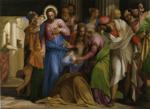
c.1548. Oil on canvas. 117.5 x 163.5 cm. The National Gallery, London, UK.
- Holy Family With Saint John The Baptist, Saint Abthony Abbot, And Saint...

c.1551. Oil on canvas. 3313 x 190 cm. Church of San Francesco della Vigna, Venice, Italy.
- Jupiter Expelling The Vices. Detail.
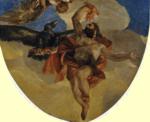
c.1554-55. Oil on canvas. 560 x 330 cm. Louvre, Paris, France. Read Note.
- Coronation Of Esther.
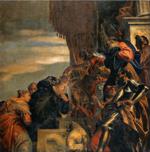
c.1555-56. Oil on canvas. 450 x 370 cm. Church of San Sebastiano, Venice, Italy. Read Note.
- The Marriage Feast At Cana.
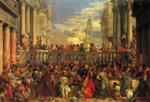
1562-1563. Oil on canvas. 666 x 990 cm. Louvre, Paris, France. Read Note.